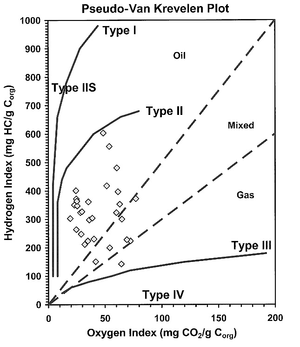Difference between revisions of "Type IIS kerogen"
Jump to navigation
Jump to search

(Created page with "File:VanKrevelanDiagram.png|thumb|300px|Van Krevelen diagram.<ref>Dembicki, H., 2009, [http://archives.datapages.com/data/bulletns/2009/03mar/BLTN08076/BLTN08076.HTM Three c...") |
|||
| Line 6: | Line 6: | ||
{{stub}} | {{stub}} | ||
| + | |||
| + | ==See also== | ||
| + | * [[Kerogen]] | ||
| + | * [[Type I kerogen]] | ||
| + | * [[Type II kerogen]] | ||
| + | * [[Type III kerogen]] | ||
| + | * [[Type IV kerogen]] | ||
==References== | ==References== | ||
{{reflist}} | {{reflist}} | ||
Latest revision as of 21:10, 6 July 2015

Van Krevelen diagram.[1]
Hydrogen indices in the range of Type II kerogen, but sulfur-rich type IIS kerogens contain uncommonly high organic sulfur (8-14 wt. %, atomic S/C ≥ 0.04) and begin to generate oil at a lower thermal maturity than typical type II kerogens with less than 6 wt. % sulfur;[2] type IIS pathway on Van Krevelen diagrams.[3]
This article is a stub. You can help AAPG Wiki by expanding it.
See also
References
- ↑ Dembicki, H., 2009, Three common source rock evaluation errors made by geologists during prospect or play appraisals: AAPG Bulletin, vol. 93, issue 3, pp. 341-356.
- ↑ Orr, W. L., 1986, Kerogen/asphaltene/sulfer relationships in sulfur-rich Monterey oils: Organic Geochemistry, v. 10, p. 499-516, doi: 10.1016/0146-6380(86)90049-5.
- ↑ Peters, Kenneth E., David J. Curry, and Marek Kacewicz, 2012, An overview of basin and petroleum system modeling: Definitions and concepts, in Peters, Kenneth E., David J. Curry, and Marek Kacewicz, eds., Basin modeling: New horizons in research and applications: AAPG Hedberg Series no. 4, p. 1-16.